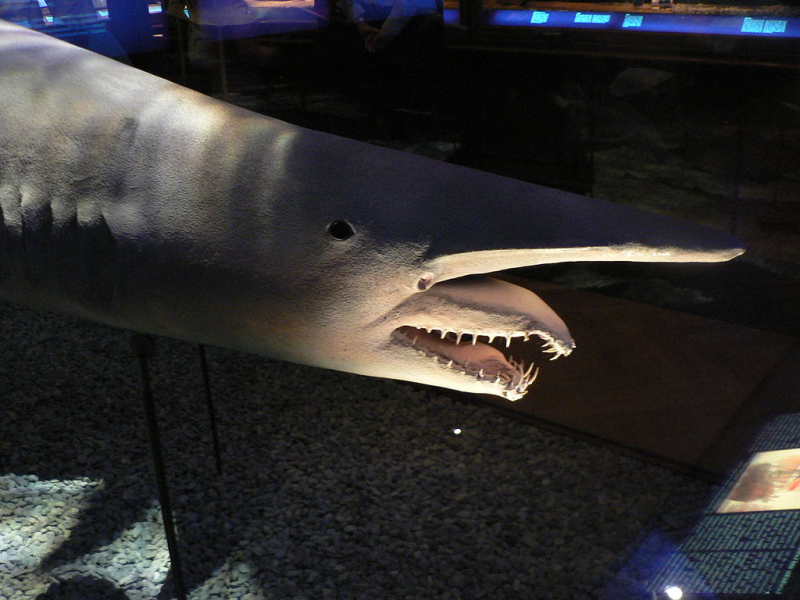Top 8 Weirdest Deep Sea Fish
Up to now, the deep sea is still one of the mysteries for mankind, it is full of strange and interesting sea creatures. Exploring marine life in the deep sea ... read more...is still a challenge for humans. Let's take a look at Toplist with the weirdest deep sea fish!
-
One of the weirdest deep sea fish is the frilled shark. The two remaining shark species in the Chlamydoselachidae family are the frilled shark and the southern African frilled shark. Because of its primitive, anguilliform morphological characteristics, including its dark-brown hue, amphistyly, and a 2.0 m-long body with dorsal, pelvic, and anal fins placed towards the tail, the frilled shark is regarded as a living fossil. The term "frilled shark" refers to the six pairs of gill slits at the shark's throat, which have a fringed look.
One of the oldest species on earth, the frilled shark, has undergone very little evolution since prehistory, earning it the moniker "living fossil". It distinguishes out for being a long, bulky animal that averages 2 meters in length, while some individuals can grow as long as 4 meters. It can eat big prey thanks to the strength of its 300 teeth and 25-row jaw. They can absorb the little oxygen that is present in the deep sea because of their six-gill holes. Their primary food sources are fish, squid, and sharks.
The waters of the outer continental shelf and the upper-to-middle continental slope are among the habitats of the frilled shark, which prefers upwellings and other biologically productive regions. Despite typically inhabiting areas near the ocean floor, the frilled shark's diet of cephalopods, smaller sharks, and bony fish suggests that it engages in continuous vertical migration and rises to the ocean's surface at night to feed.

Photo: npr.org 
Photo: livescience.com -
The dumbo octopuses, or Grimpoteuthis, are a genus of pelagic umbrella octopuses. Due to their striking ear-like fin that protrudes from the mantle over each eye and resemblance to the main character of Disney's 1941 film Dumbo, they were given the moniker "dumbo." The genus contains 17 known species. Crustaceans, bivalves, worms, and copepods are among the prey. Grimpoteuthis species vary in life expectancy from 3 to 5 years.
With some specimens found or observed in hadal depths, dumbo octopuses are the deepest living octopuses that are currently known. A single Grimpoteuthis sp. specimen was found at a depth of 7,279 meters, but this distance from Grand Cayman is questionable. However, Grimpoteuthis was discovered in 2020, 6,957 m below the surface of the Java Trench, confirming the genus' hadal spread.
These creatures, which can be found between 2000 and 5000 meters deep, eat bivalves, copepods, crustaceans, worms, and crustaceans. The average life span of different species of Grimpoteuthis has been observed to be 3 to 5 years. Humans do not pose the same threat to these animals as do their natural predators, such as sharks.
Because these octopuses lack an ink sac, they defend themselves from predators by changing colors and becoming indistinguishable from their surroundings. They even occasionally become transparent. They can also perceive light thanks to white patches over their eyes.Video: https://www.youtube.com/watch?v=YcoMEaBjJLk 
Photo: aquariumofpacific.org -
The next position on the list of the weirdest deep sea fish is the Goblin shark. A rare deep-sea shark species is the goblin shark. It is the sole surviving member of the 125 million year old family Mitsukurinidae, which is sometimes referred to as a "living fossil." With an elongated, flat snout and strongly protruding jaws bearing conspicuous nail-like teeth, this pink-skinned mammal has a striking character. When mature, it is typically between 3 and 4 m long, although it can get much bigger, like the one that was reportedly taken in 2000 and measured 6 m.
Benthopelagic goblin sharks are found at depths more than 100 m throughout the world on upper continental slopes, underwater canyons, and seamounts. Adults are often found at a higher depth than juveniles. Some scientists think that these sharks might also dive for brief periods of time to depths of up to 1,300 meters.
Having said that, the creature's capacity to expand its jaw forward as it opens its mouth. Cephalopods, crabs, and teleost fish make up the majority of their food. These fish rarely interact with people. Some are used to make liver oil in Japan after being caught as bycatch. A small number of specimens were captured alive and brought to public aquariums, but they quickly perished.

Photo: wikipedia Video: https://www.youtube.com/watch?v=3sOeqVU7Y7k -
A type of carnivorous deep-sea sponge called the harp sponge, also known as the lyre sponge, was initially found by Welton L. Lee, Henry M. Reiswig, William C. Austin, and Lonny Lundsten from the Monterey Bay Aquarium Research Institute off the coast of California.
Typical sponges are suspension feeders that use their aquiferous system to filter out bacteria and other small creatures from the water around them. However, C. lyra and other carnivorous sponges use the velcro-like hooks on their external body surfaces to catch much larger prey, such as copepods and other crustaceans. Once the prey is caught in the sponge's hooks, the prey is broken down so that the C. lyra can absorb it through its pores by means of a digestive membrane that is secreted by the sponge.
Off the coast of northern California, in the northeast Pacific Ocean, at the Escanaba Ridge and the Monterey Canyon, Chondrocladia lyra has been discovered. With estimations ranging between 3,000 and 5,000 m, specimens have been discovered in soft abyssal sediment at depths between 3,316 and 3,399 m, attached to the seafloor by rhizoid that resembles roots. In the Monterey Canyon, where their prey is drawn into the small crevasses the sponges occupy, they have been spotted rooted on the sides of hills and the canyon's floor. Although it has only been seen off northern California, it probably has a latitudinal range of at least 1,600 kilometers.
Photo: mbari.org Video: https://www.youtube.com/watch?v=VC3tAtXdaik -
The "Vampire Squid From Hell," also known as the vampire squid, is a spooky deep-sea mollusk that may be found all over the warm oceans of the planet. The ability of these creatures to exist in a unique environment known as an oxygen minimum zone is what makes them so peculiar. Very few organisms can survive in OMZs because of the incredibly low levels of oxygen present there. Instead of ink sacs, these squids have the ability to emit a cloud of bio-luminescent many orbs of blue light that can blind an assailant and cause him to flee into the deepest darkness. Despite their frightening name and look, these creatures are harmless to people because they can only reach a maximum size of roughly 6 inches.
Small cephalopods called vampire squids can be found in the deepest parts of temperate and tropical oceans. The vampire squid thrives in areas of the water with the least amount of oxygen due to its bioluminescent organs and distinct oxygen metabolism.
Although octopuses and squids are their closest relatives, it is distinguished from them by having two long retractile filaments that are situated between the first two pairs of arms on its dorsal side. This characteristic places it in its own order, Vampyromorphida. It is the only known surviving member of its order and a phylogenetic remnant. The first specimens were found during the Valdivia Expedition and were initially classified as an octopus by German teuthologist Carl Chun in 1903; however, they were eventually placed in a different order along with a number of extinct taxa.
Photo: wikipedia 
Photo: sciencenews.org -
Any species of marine fish in the genus Chauliodus is referred to as a viperfish. The mesopelagic zone is the primary habitat of viperfish, which are distinguished by their long, needle-like teeth and movable lower jaws. An average viperfish can reach lengths of 30 cm. The world's tropical and temperate oceans are home to viperfishes, which migrate vertically every day. In order to blend in with the less than 1% of the light that travels below 200 meters of depth, viperfishes have photophores along the ventral side of their bodies.
Viperfishes inhabit meso- and bathypelagic settings, which are difficult for humans to directly see. Viperfish travel vertically throughout the day, moving up into more fruitful areas at night to feed. Due to their slow metabolism, or the fact that they probably do not need to eat every night, it is possible that only a portion of the entire viperfish population engages in diel vertical migration on any one night.
Depending on the species, viperfishes eat crustaceans and other pelagic fish. Lanternfish, bristlemouths, copepods, and krill have all been discovered in the stomachs of captured individuals.
Photo: mbri.org Video: https://www.youtube.com/watch?v=f0m1ezXBhvo -
A peculiar anglerfish species that excels in mimicry and concealment is the frogfish. Frogfishes move occasionally, but when they do, they move virtually like frogs by pushing off with their two legs. This unusual fish can use its ribs to move forward in open water while forcing its open gills, which are located behind its pelvic region, to breathe.
Any fish classified as a frogfish belongs to the Lophiiformes order's Antennariidae family of anglerfish. In Australia, members of the unrelated family Batrachoididae are referred to as "frogfish," but antennariids are known as anglerfish there. With the exception of the Mediterranean Sea, frogfish are present in practically all tropical and subtropical oceans and seas.
Small, short, and stocky, frogfishes occasionally have spinules and other appendages to help them blend with their surroundings. They can use camouflage to entice prey and protect themselves from predators. Many species have the ability to change color, and some have other life forms like algae or hydrozoa covering them. Frogfishes normally move slowly while waiting for prey before striking extremely quickly—in as little as 6 milliseconds—to maintain their camouflage.

Photo: wikipedia 
Photo: bienvanguoi.wordpress.com -
One of the weirdest deep sea fish is the psychedelic frogfish which comes from its eye-catching white and pink striped fingerprint pattern. This fish, like its relatives, usually lives in the waters off Bali, Indonesia, and has meaty, flabby skin. The lack of scales and potential protective mucus covering this fish are what make it so unique. This animal's gaze is extremely psychedelic, and viewing it while using substances that cause hallucinations is not advised.
The pink and white stripes of the psychedelic frogfish, which has a yellow-brown or peach coloration, are grouped in the shape of a fingerprint. The fish was caught in waters close to Bali and Ambon Island in Indonesia.
Pietsch, Arnold, and Hall first identified the psychedelic frogfish in the scientific journal Copeia in 2009. They stated that it had "a striking pigment pattern of white swirling stripes," hence their usage of the word psychedelic. The psychedelic frogfish can grow up to 15 centimeters in length. Like other frogfish, the skin of the psychedelic frogfish is thick and flabby. It lacks scales since it belongs to the Lophiiformes order. The fish's dorsal and ventral fins are covered by the skin, which helps the fish blend with its surroundings.

Photo: michaelaw.photoshelter.com video: https://www.youtube.com/watch?v=h-OUEd9Xih4





























